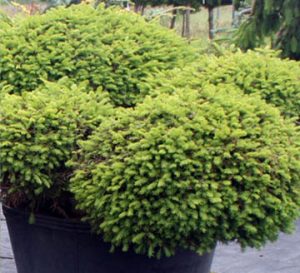
It’s December and we have had more than one hard frost. The perennials and ornamental grasses have died back. The leaves are off the tree. If not for the dwarf conifers, your garden would be barren. During the winter months it is your evergreen shrubs that add the texture and color that are the mainstays of your winter garden.
Dwarf conifers can take the form of pillars, round balls or flat ground covers that add that visual punch that is needed for your winter garden.
Green Arrow Weeping Alaska Cedar: (Chamaecyparis nootkatensis) Tall and narrow growing to 20 feet in 10 years.
Dwarf Colorado Blue Spruce: (Picea p. ‘Glauca Globosa’) Globe shaped conifer growing to 3-5 feet with bright blue color. Hardy down to -40 degrees F.
Weeping White Pine (Pinus strobus ‘Pendula’) Grows to 15 feet tall with a 10 foot width with graceful weeping branches. It has blue green foliage with long ornamental needles.
Weeping Blue Atlas Cedar (Cedrus libani (ssp.atlantica)’Glauca Pendula’). Makes an ideal specimen tree with its drooping and twisted branches. Powdery blue needles are attention grabbing. 10 feet tall and 15-20 feet wide at maturity.
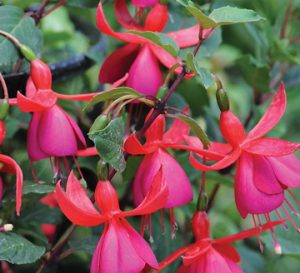
This tropical looking flowering shrub will bloom all summer and through the fall. The Fuchsia pictured in this blog posting was photographed just a week ago in a Vancouver, WA garden
Winter hardy Fuchsias not only grow, but thrive in the Portland – Vancouver, WA area. They need sun, with full sun being best. Plant them in a well-drained location. Sandy soils with added organic material work well.
The best time to plant is in the spring of the year, but planting can be done through the summer and into early fall.
Winter care of cold hardy (winter hardy) Fuchsias: Allow the frost to kill all of the leaves and trim back the all the non-woody growth. In the spring when green shoots appear, prune the plant back hard and work into the soil a general fertilizer. Fertilize again in August.
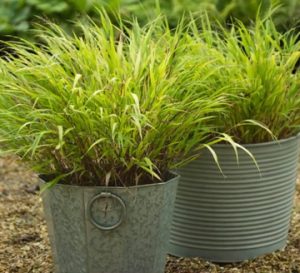
This is a graceful looking ornamental grass that is a member of the Hakonechloa family. Its bright colors and textures light up the garden. Japanese forest grass does best in full shad or partial shade. It is slow growing and takes little care once it is established.
Japanese forest grass is available in striped (variegated) or solid and comes in several colors. Colors include Gold or Green with white or gold stripes. Their elegant textures add character to your garden. It typically grows 18-24 inches high with its blades forming arches that flow back down to the ground.
Soil should be well draining and kept moist. Add soil amendments for best growing conditions. Grows well in partial shade. Combines well with Hastas in the garden.
Older plants can be dug up and divided to form new bunches. This dividing is best done in the spring or fall. Remove the dead leaves in early spring before the new growth forms.
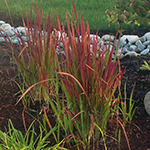 Japanese Blood Grass is a popular ornamental grass. It is known for the deep red hues that develop in the latter part of the summer and carry into the fall. Japanese blood grass will typically stand 1-2 feet tall and grow in clumps 2 feet in diameter. This makes an excellent accent in the garden.
Japanese Blood Grass is a popular ornamental grass. It is known for the deep red hues that develop in the latter part of the summer and carry into the fall. Japanese blood grass will typically stand 1-2 feet tall and grow in clumps 2 feet in diameter. This makes an excellent accent in the garden.
Japanese Blood Grass grows well in full sun and will also do well in partial shade. It does take a good exposure to the sun to develop the characteristic blood red color each summer. It prefers moist to wet soil that drains quickly.
Imperata cylindrical will typically die back in late fall or early winter. As part of your winter maintenance, trim away the dead grass on each clump to a height of 2-3 inches. Trimming too short can damage the crown that will sprout new growth next spring.
Plant the Blood Grass clumps no closer than 2 feet apart. Japanese Blood grass will continue to spread by sending out lateral runners that are just 1-2 inches below the soil surface. You can contain a clump by placing a 6 inch deep barrier around a clump. This grass also grows well in containers or large wooden barrels.
Japanese Blood Grass does not need to be fertilized.
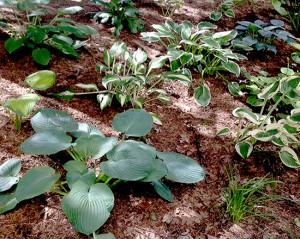 The above photo was taken just outside the office of Far west Turf Farm and Nursery. Hosta are our specialty plant that we grow and sell along with our full line of nursery plants. more on Vancouver, WA hastas.
The above photo was taken just outside the office of Far west Turf Farm and Nursery. Hosta are our specialty plant that we grow and sell along with our full line of nursery plants. more on Vancouver, WA hastas.
Hastas are known for their beautiful foliage and are easy to grow. They are a resilient perennial. They thrive in shade and will grow in partial and even full sun. They are a low maintenance plant that grows very well in the Pacific Northwest.
Best times to plant: When are the best times to plant? They can be planted anytime the ground can be worked. The best planting times are in early spring when they are actively making new roots and in the early fall just after the intense summer heat has let up. Late August and September are the perfect times for the hostas fall planting.
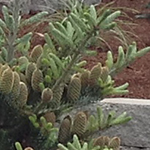 Looking for a showpiece for your garden? Then look to the ‘Horstmann’s Silberlocke’ Korean fir. The needles are held in whorls so the silver underside is shown as is the darker top needle giving a glistening look to the tree. It is sometimes referred to as a “flocked” noble fir.
Looking for a showpiece for your garden? Then look to the ‘Horstmann’s Silberlocke’ Korean fir. The needles are held in whorls so the silver underside is shown as is the darker top needle giving a glistening look to the tree. It is sometimes referred to as a “flocked” noble fir.
As with all true firs, the Hortsmann’s Silberlocke Fir bears upright cones near its tree top.
This dwarf conifer will grow to a height of approximately 15 feet with a width of about 5 feet. It is a slow grower that increases 3-6” per year until reaching its full height.
Does best in the full sun and regular watering. Watering can be reduced once it is established. Feed with a general purpose fertilizer before growth begins in the spring.
Regularly available Vancouver, WA and Portland dwarf conifers from Far West Turf and Nursery.
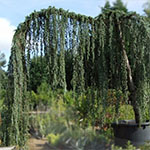 Urban gardeners usually have to work with smaller spaces. Dwarf conifers can be smaller or miniature species that come in all sorts of colors, textures, colors form and shapes. They add visual interest and character to a garden.
Urban gardeners usually have to work with smaller spaces. Dwarf conifers can be smaller or miniature species that come in all sorts of colors, textures, colors form and shapes. They add visual interest and character to a garden.
Limited space does not need to mean limited enjoyment. They are very versatile and work with many different garden types. They can accent water features. Use them in mixed plantings with annuals, bulbs and shrubs that change so much through the seasons.
Weeping Blue Atlas Cedar pictured above provides a striking shape along with the blue green needled foliage. Others such as the Golden Dwarf Hinoki Cypress can bring beautiful yellow accented foliage to the garden.
Come see our selection of dwarf conifers.

